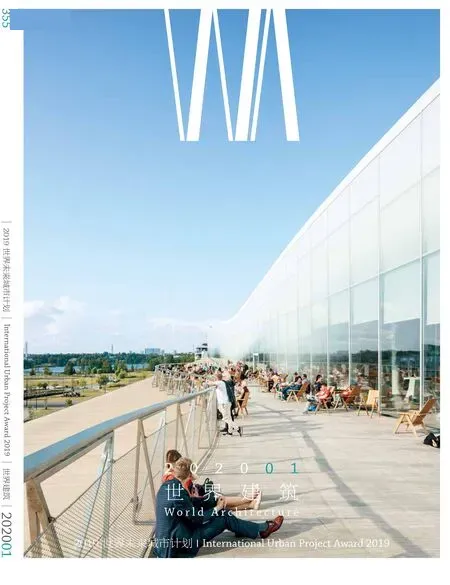下一个十年,建筑的未来
鲍里斯·沙德-宾索
庞凌波 译
在未来的10年里,建筑师、工程师、城市规划师和基础设施规划师的成就,不仅将决定我们未来建成环境的可生存性,也将不容置疑地决定我们社会的可持续性。若他们失败,诸如气候变化、人口变化等今日之挑战,将演变成不可估量的危机。所需的解决方案是多元复杂的,单一策略无法产生我们需要的结果。这种情况呼吁着跨学科的合作,这种合作已然超越了我们的专业范畴。我们的首要任务,是集中建设力量满足社交与社会的需求和变化,这意味着以经济为首要地位创建规则和框架,来促进我们社会的发展稳步提升。
世界未来城市计划(IUPA)旨在颁发给那些满足以下一项或多项要求,并始终对社交与社会发展有突出贡献的项目。
材料
迄今为止,建筑与基础设施似乎总是为了永久保留而设计的。建筑构件与产品、系统在这样的前提下相互连接,这样一来,它们永远不会被分离成单独的构成元素。但这意味着建筑工业作为一个整体比任何其他行业都要产生更多的垃圾。事实上,全世界有超过40%的废物是由建筑产生的。若要改善这种情况,一种全新的施工方法很有必要,这种施工方法将极大地受到最新型连接技术的影响。未来,建造可能不再是黏合、焊接或涂抹水泥砂浆,而是用螺丝接合,或是装配式,鉴于这是唯一可以确保建筑在将来仍可被拆分成有价值的独立构件的建造方式。
虽然混凝土、玻璃和钢材在过去一直是建筑材料的首选,但未来需要可持续的、能耗更低的新型替代材料。我们将看到黏土、木材和砖比以往发挥更大的作用。
耐久性
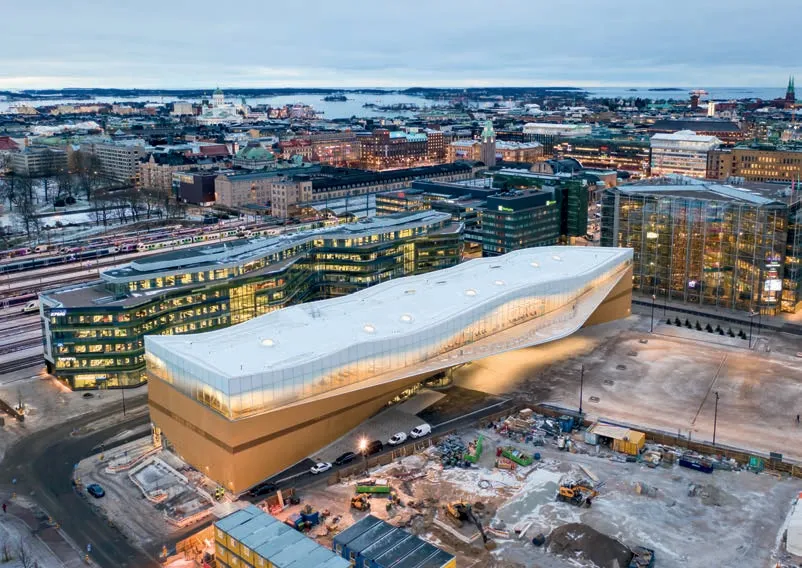
1 芬兰赫尔辛基颂歌中央图书馆位于赫尔辛基市中心,采用 在地材料建造。立面贴材使用芬兰云杉,随着时间的变化, 其颜色将朝着更深沉更丰富的原木色彩演变/The Helsinki Central Library Oodi completed at the heart of Helsinki, Finland, which has been built using local materials. The wooden façade is made of Finnish spruce. The appearance of the façade will develop over the years towards a deeper, richer version of its initial hue(摄影/Photo: Tuomas Uusheimo)
我们的建筑必须更加耐用,这其实并不是在讨论静力学、支撑结构或稳定性,而是在考虑到内部与外部变化的基础上提出来的耐久性要求。如今的建筑设计多半只能满足一种运作状态和单一类型的使用:例如办公大楼始终是办公大楼,住宅建筑就是住宅建筑,生产设施也只作为生产设施使用。展望未来,我们需要在开始设计建筑时,就采取一种方式,不仅能够使建筑可以承载其他的用途,而是切实地拥抱这种可能性。唯一可以实现这一点的方法,就是在一开始就设计和建造尽可能可以灵活使用的建筑。
从运行的角度,建筑也应当更加耐久。当今的建筑主要是为适应气候状况而优化的,这样可以尽可能少地消耗能源。几十年来,人们关注的焦点始终是在尽量削减对化石燃料的消耗上。这种改进带来的是,即使是对运作状态最小的扰动也会破坏平衡,并且最终导致建筑比预期消耗更多的能量。然而在未来,内外部的变化只会更频繁,在使用行为习惯上的调整使得对建筑运作技术的反复调试十分必要,然而适用于此种目的的建筑系统正在变得愈加复杂而几乎不可能操控。除此之外,当然,还有外部环境的变化。气候变化带来的影响使建筑暴露在比以往任何时候都更加多样化的环境条件下,甚至在某些时候,这些条件更加极端,人们期望建筑能够抵御这些变化。这就要求技术不仅要更加明确,而且要更加灵活。实际的建筑外壳应当从结构的角度改进,体积指数、朝向以及储能容量都应当得到很大程度上的提升。
能源与数字化
在过去的150年中,建筑对化石燃料的使用几未受限。毕竟,如果没有这些化石燃料,过去几十年建造的建筑根本不可能存在。玻璃幕墙摩天大楼、巨大的工业厂房、玻璃天顶的中庭以及大规模的公共建筑都有赖于这些看似廉价的能源来实现环境调控和气候控制。今天,数以百万计的住宅建筑受益于供暖和制冷系统,这种情况不太可能改变,鉴于无论如何也没有人会自愿放弃现有的舒适。不过我们现在可以改变采用的能源。在未来,建筑的电能供给将由可再生能源实现,不过如果我们真的要充分利用这个条件,那就有必要改变我们视建筑为孤立个体的观念。相反,建筑可以彼此共享、优化需求和功能,它们预测自己的能源需求或能源剩余,并与周边其他建筑共享这些信息。能源流的分配和控制通过复杂的自主学习算法控制系统中所有建筑的数字网络来实现——不仅包含了使用者的行为和移动的数据,还有对这些数据的预判。
Over the next 10 years, the achievements of architects, engineers, town planners and infrastructure planners will determine not only the future viability of our built-up environments, but also the sustainability of our society in no uncertain terms. If they should fail, today's challenges such as climate change and demographic change are set to evolve into incalculable risks. The solutions needed are complex. Individual measures alone will not deliver the results we need; the situation calls for interdisciplinary cooperation that extends far beyond the boundaries of our profession. The priority here is focusing our building efforts on social and societal needs and change, which means creating rules and structures for economic primacy aiming to promote the development of our society both as it stands and going forward.
The International Urban Project Award (IUPA) will be presented to projects that meet one or more of its requirements and that always make a contribution to social and societal development.
Materials
Until now, buildings and infrastructure have always been built as if designed to remain in place for eternity. Building components, products and systems are joined together in such a way that they can practically never be separated out into their individual constituent elements. But this means that the construction industry as a whole is responsible for producing more waste than any other industry. In fact, more than 40% of waste generated worldwide can be attributed to building. If this is to change, we are in need of an entirely new approach to construction, which will be heavily influenced by all-new joining and connecting technology. In the future, building will no longer be characterised by bonding, welding and mortar, but by screwing and assembling, as this is the only way to ensure the building can be disassembled into its valuable individual components further down the line.
While concrete, glass and steel have traditionally been the building materials of choice in the past, the future is calling for sustainable new alternatives that are less energy-intensive. We will see clay, wood and brick playing a greater role than ever before.
Durability
Our buildings simply have to become more durable. This is actually less to do with their statics, supporting structures and stability and more to do with durability with regard to changes in internal and external influences. Buildings today are designed to facilitate just one operational state and a single type of use: for example, an office block remains an office block, a residential building remains a residential building, and a production facility remains a production facility. Going forward, we have to start designing buildings in a way that not only facilitates alternative uses, but actually welcomes them. The only way to achieve this is for architects to design and construct a building that is as flexible as possible right from the outset.
Buildings also have to become more durable in terms of how they operate. Today's buildings are optimised for a climatic operating state, which should be created using as little energy as possible. The focus for decades has been on minimising the consumption of fossil fuels. As a result of making this improvement, even the slightest disruption to the operating state would cause an imbalance, and the building would end up consuming even more operational energy than ever intended. In future, however, there are set to be more changes both from within as well as externally. Adjustments in usage behaviour make it necessary to adapt the operating technology over and over again, yet the systems suitable for this purpose are becoming increasingly complex and almost impossible to control. And then, of course, there are the external changes. The effects of climatic change will see buildings exposed
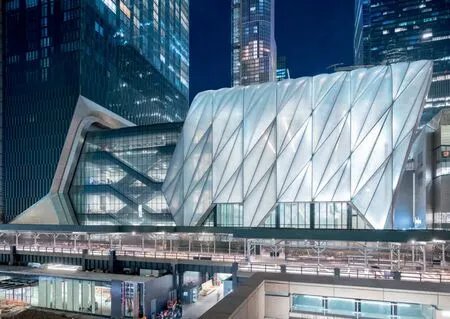
2 从美国纽约第30街看向艺术棚的夜景。这个可移动的“棚 子”对于未知的未来保持着灵活性,并能应对规模、媒介、 技术和艺术家不断发展的需求等诸多变化/Evening view of The Shed from 30th Street, New York, USA. The movable "shed" can be permanently flexible for an unknowable future and responsive to variability in scale, media, technology, and the evolving needs of artists(摄影/Photo: Iwan Baan, 供图/Courtesy of The Shed)
比例与人体尺度
建筑与公共空间的规模应当契合人体尺度,而不是超过这个尺度。对于公共空间而言,这意味着建筑与基础设施应当直接服务于社交互动,实现直接的视线交流。这同样与建筑的高度有关,鉴于它要求城市的人视视角而不是上帝视角。公共空间不能被精英化,而是对所有人一视同仁且不带来任何消费压力。
社会与人口学
社会总会受到人口变化的影响,而且随着时间的推移,平均年龄增长,人口变化往往会缩小。这个过程并没有什么惊人之处,事实上,它很容易计算。人口变化同时也是不可逆转的。无论人口政策有多么明智,出生率在未来两代内都不会上升了,因为女性群体中,已经基本没有愿意生育小孩以逆转老龄化的人了。
这是社会必须面对和适应的问题,不论是好是坏。为此,必须为这些社区提供足够的居住和工作空间。
社会公平
人人有权在合适的地方拥有合适的居所。如果这一点长期得不到保障,我们的社会将分崩离析,因为那些拥有住房的人与那些无住房的人之间将形成一道难以逾越的鸿沟。社会体系的崩溃也会在我们生活的其他方面隐现,在那些有经济负担的人和没有经济负担的人之间,在教育、文化、健康、能源,以及许多其他领域皆是如此。社会公平也表现在建成环境中,也就是说,建筑应为所有人提供平等的空间和机会。
建筑与美
建筑不仅仅是对空间的美学演绎。在维特鲁威的经典解析中,建筑基于坚固、实用、美观三原则。今天,这三项原则不再被平等对待,美正在失去它的重要地位。这实在是错得离谱——建成环境的美学正是其社会生活的真实写照。我们必须铭记这一点,因为我们是通过不断回顾那些造就了今天的我们的过去,来明确我们对自己的身份认知。我们不能简单剥夺未来几代人的这项权利。我们有责任确保为他们提供共同身份认知的场所。
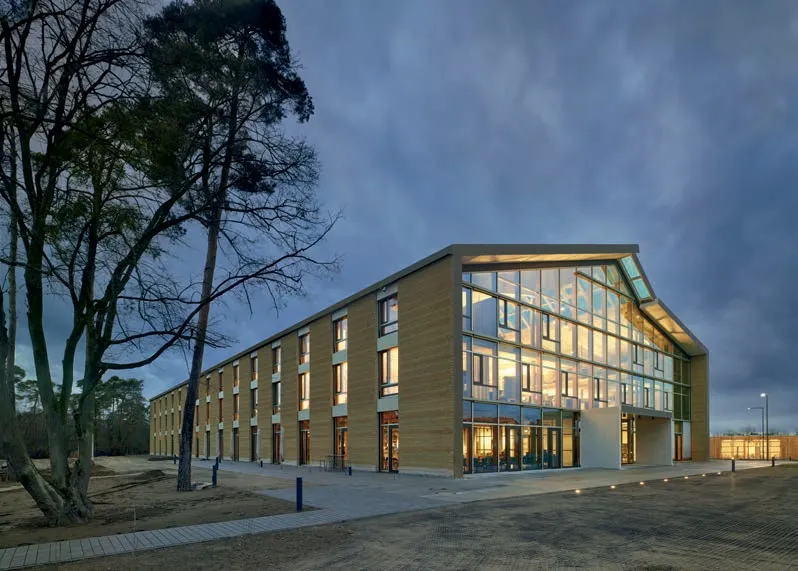
3 德国达姆施塔特市的安娜图拉工作园区的新总部大楼采用了独特的创新夯土外墙,是世界上第一个墙身加热供暖的建成实例/The new headquarter building of Alnatura Arbeitswelt in the city of Darmstadt, Germany, offers special features such as the use of an innovative rammed-earth façade and it is the first worldwide instance of using geothermal wall heating(摄影/Photo: Roland Halbe)
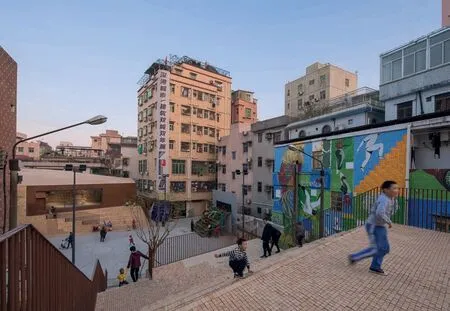
4 位于中国深圳城市中心的南头古城,在近百年间,城市与村庄此消彼长、环环相扣,呈现出了复杂的空间格局。都市实践为南头古城保护与更新提出了以介入实施为导向、由点及面渐进式激活、以文化活动促进古城复兴的发展模式/The Nantou Old Town in the city centre of Shenzhen, China, in the past century, the historic town has gradually vanished, while the village was constantly expanding. The exacerbation of urbanisation in Shenzhen has resulted in an intertwined layering with complex pattern of the historical town embedded in the urban village, which is again encircled by the city. Urbanus proposed a development model of promoting the rejuvenation of the ancient city with the guidance of the intervention, promoting the revival of the ancient city with cultural activities with the gradual activation from point to surface(摄影/Photo: 张超/Zhang Chao, 图片版权/Copyrights: ©UABB)
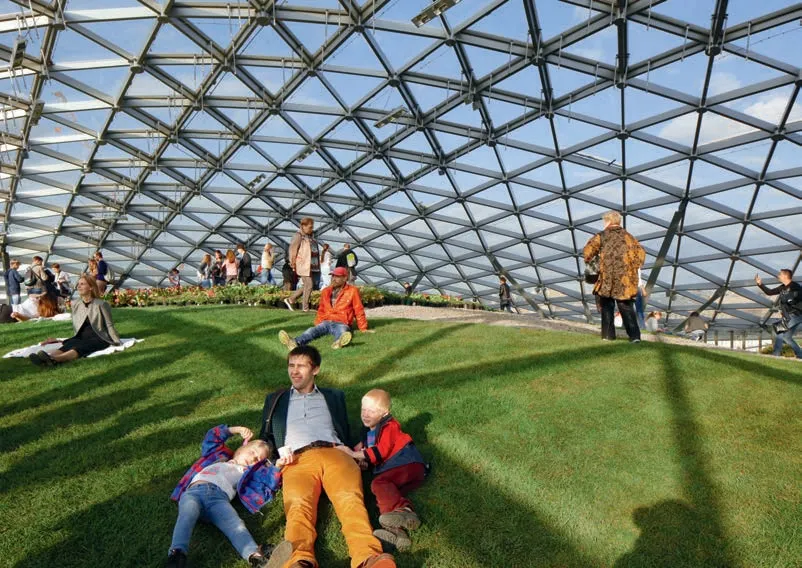
5 作为俄罗斯莫斯科在近50年中建造的首个大型公园,扎里亚季耶创造了一个难以归类的公共空间。到达这里的每一位游客都能感受到专门为他们创造、也是由他们创造出来的场所/As the first large scale park to be built in the last 50 years in Moscow, Russia, Zaryadye provides a public space that resists easy categorisation. Each visitor's experience is customised for them and by them in there(摄影/Photo: Philippe Ruault, 供图/Courtesy of Diller Scofidio + Renfro)
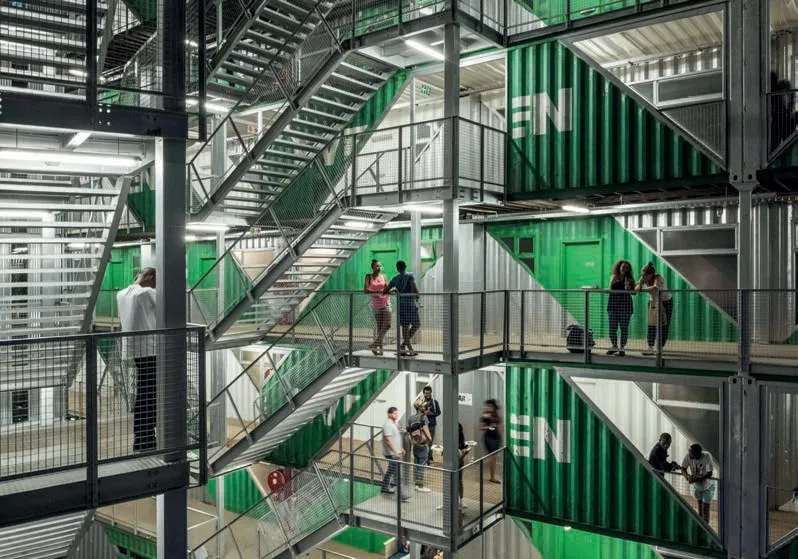
6 南非约翰内斯堡的住宅楼——传动组公寓,其社会含义和议题与其周边新兴的城市社区相一致,在城市的振兴、再活化和重塑中发挥着积极的作用。他们想要传达的信息是明确的:这个城市,尤其是其中心,应该再次平等地属于每个人/Drivelines Studios is a residential building in Johannesburg, South Africa. The building's social intention and agenda is in line with the emerging urban community of its surrounding neighbourhood, taking an active role in the revitaliasation, reactivation and reimagining of the city downtown. The message here is clear: this city, and above all its centre, should belong to everyone equally once again(摄影/Photo: Dave Southwood)
世界未来城市计划奖的获得者,不论是已获奖的还是将在未来获得这项荣誉的,都或多或少地会满足以上这些面向未来的建筑特征。而他们的共同点则体现在,他们展现了对社交与社会责任的郑重承诺。□to more diverse - and in some cases more extreme - weather conditions than ever before, and they will be expected to stand up to them. This calls for the technology to be not only more straightforward, but also more flexible. The actual building shell has to be improved from a structural point of view, and the cubic volume, orientation and storage values have to be included to a much greater extent.
Energy and digitalisation
In the last 150 years, architecture has been characterised by the unrestricted use of fossil fuels. After all, if it were not for fossil fuels then the buildings erected over the past decades would not have been possible at all. Skyscrapers with glass facades, huge industrial halls, glass-covered atriums, and huge public buildings all relied on the seemingly cheap energy available in abundance for air conditioning and climate control. Today, millions of residential buildings benefit from heating and cooling systems, which is a situation unlikely to change, since no one would voluntarily give up comfort like this on any level. But we must now change the energy source. In the future, buildings will be powered by electricity generated from renewable sources, but if we are to really make the most of this situation, then it is essential for us to stop considering buildings as solitary entities. Instead, buildings will have to share and optimise their needs and usage in combination with other buildings. They will have to anticipate their own future energy requirements or surpluses and share this information with other buildings in the surrounding areas. The distribution and control of energy flows can only be achieved by digitally networking all buildings in a system controlled by complex, self-learning algorithms. This also involves not only including the behaviour and mobility of the users, but also anticipating them.
Proportion and human scale architecture
Buildings and public spaces must be adapted to the human scale; the dimensions must not exceed this scale. For public spaces, this means that the buildings and infrastructure should directly facilitate social interaction, allowing for direct eye contact. This is also relevant in terms of the height of the building, as there must be the possibility of a direct view into the city and not beyond. Public spaces must not be elitist; they must be available to all equally without any pressure to consume.
Society and demography
Every society is affected by demographic change, often shrinking as time goes on, with the average age of the population rising. There is nothing phenomenal about this process; in fact, it is easy enough to calculate. It is also irreversible. The birth rate will not rise within the next two generations no matter how clever family policy is, because the women who were supposed to have these children in order to reverse the process of increasing the average age were never will be born.
This is something society will have to adapt to, whether it likes it or not. And to do so, adequate space must be made available to provide these communities with somewhere to live and work.
Social justice
Everyone has the right to adequate housing in an appropriate place. If this cannot be guaranteed in the long term, our society will fall apart at the seams, since a division will form between those who can afford housing and those who cannot. This societal collapse is also looming in other areas of our lives between those who can afford mobility and those who cannot, and it continues to be the case in education, culture, health, energy and many other areas besides. The social justice of a society also finds expression in the built-up world, which must provide equal space and access for all.
Architecture and beauty
Architecture is about more than just the aesthetic examination of space. In the classical understanding of Vitruvius, architecture is based on the three principles of strength (Firmitas), functionality (Utilitas) and beauty (Venustas). Today, these three principles are no longer treated equally, as beauty is losing its significance. But this is a real mistake, since the aesthetics of the built-up world reflect the identity of the society living within it. This is essential to remember, because the way we assure ourselves of our identity time and again is by revisiting past places that have made us who we are today. We simply cannot deprive future generations of this opportunity; it is our responsibilities to ensure that they have a place of common identity.
The past and future winners of the International Urban Project Award each tick one or more of various boxes associated with future-oriented architecture. But what they all have in common is that the projects demonstrate their commitment to social and societal responsibilities.□
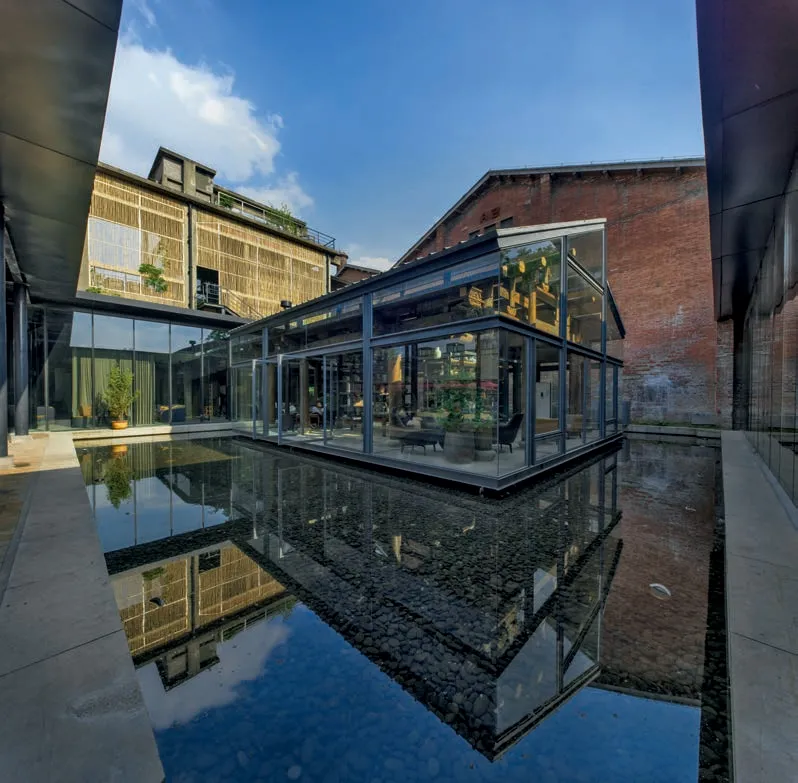
7 中国江西的陶瓷产业代表城市景德镇,在陶溪川片区的保Porcelain Distric, a large area of water feature was created 护与整治详细规划中建立的大面积水景,不仅形成了旧建筑between the museum and gallery. It not only forms a surreal 和烟囱倒影的超现实形象,还可以帮助在炎热的夏天为该image of the reflection of the old building and chimney but also 场所降温/Jingdezhen is a representative city of the world ceramic helps to cool down the place in the hot summer(供图/Sources: industry, in Jiangxi Province, China. In the TAOXICHUAN 北京华清安地建筑设计有限公司)

